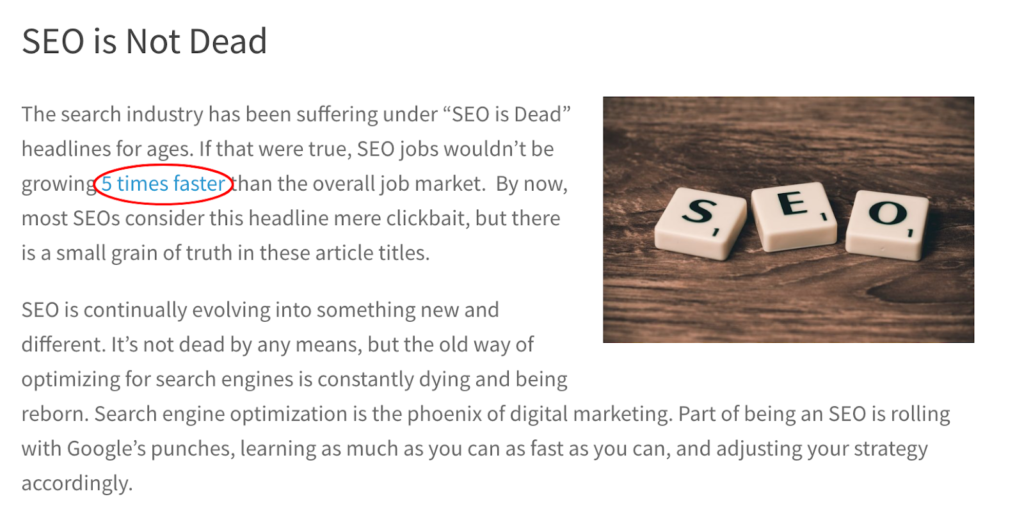Internal linking is the use of hyperlinks that target and lead to other sites within the same domain, as a way to drive visitors from one page to another.
Why is internal linking important to your site?
As usual, all roads lead back to SEO. Links have been and continue to be ranking factors in the SEO world. But linking isn’t done just for the sake of pleasing search engines — good, natural linking throughout your site helps guide visitors to find the information they need. And if you have valuable content that naturally leads through the marketing funnel and sales cycle, you’re setting yourself up for the opportunity to ultimately convert the visitors that land on your site.
There are two main benefits to internal linking (when done correctly):
- Improved UX
- Better ranking content
However, internal linking architecture isn’t just for the user’s experience, but to help search crawlers better understand the site’s structure and which pages are most important. A larger number of links pointed toward a specific page indicates to crawlers a higher significance and helps decide what ends up in search results.
Internal linking may seem like a given and easy to implement, but if you’re not diligent in creating your site’s structure and navigation, things can quickly go south. (“Things” being your rankings, and “south” being reduced SERPs.) With an eye towards that fact, here are some SEO best practices for setting up a site’s internal linking structure.
For a deeper dive, check out Rand Fishkin’s Whiteboard Friday on internal linking structure
Internal Linking 101
When we talk about how the internet is arranged, it is usually described as a web-like structure. This explains why bots are referred to as ‘spiders’ that crawl the web.
Each website is also given a structure, but it’s up to the person creating the internal linking structure of the site to build it in a user-friendly (and crawl-friendly) way. If you want users to make their way to the converting pages of your site, be sure to guide them appropriately through the links you create — what you’re linking to is important:

Link location is key
The first link on a page or within a piece of content is considered the most important — the earlier the link, the better. In fact, after a certain point on the page, or a certain number of internal and external links, Google gives less notice and credit.
Links in the footer, for example, hold very little weight. Similarly to how a real person interacts with a site, Google’s crawl favors the main navigation bar over the footer at the end of each page.
Use relevant keywords for anchor text
When linking from one page to another within the same site, be sure to use descriptive and relevant keywords within the anchor text. The anchor text leading to the next page should be able to describe what a user will find when they click through, and these links should be credible and useful to users.
Using non-descriptive keywords that aren’t relevant to the internally linked page can seriously damage your site visibility, because if users don’t arrive at the page they expected, they’ll quickly bounce out. Tactics like this can be seen as manipulative by Google, and result in a loss in rankings.
Quality is better than quantity
Less really is more when it comes to the number of links on a page. Pages with links guided from other relevant pages tend to rank higher than those linking from random pages (and that goes for bounce rates, too).
Pages or content oozing with links carry little value, and may actually be harmful to a site’s health and rankings. Issues such as these require an audit to determine which links should be stripped to improve upon their rankings.
This illustrates the importance of making sure your links are relevant. If users never click the links within that page, or quickly bounce out, it’s a very bad sign for your site and can hurt your rankings. In other words, the careful curation of your links and pages will set your site up for success.
Auditing internal links
Performing routine audits of your site’s content can help to determine which links are actually being used, and which can safely be removed. Google’s Search Console Link Report will show you your site’s most valuable links.
Pages with many backlinks (external links pointing toward that page) hold a significant amount of weight in terms of ranking. Also known as link equity, this can be leveraged to help boost other lesser-known pages on your site, in order to build up their authority and prominence in search results.
When creating new content for your site, be sure to look back through previous content that focuses on similar topics and create links back to the new content. To help boost unnoticed pages, pages with a high quantity of backlinks can be used to improve the pages with low engagement (as long as they’re still relevant to the content.) Maintaining a regularly scheduled content audit will also allow you to see how those pages are performing and whether or not they may need a boost by either updating the content or supporting it through links.
Learn more about how SEO and call analytics can improve your business: Request your no obligation demo of CallRail, or go ahead and start your 14-day free trial, no credit card needed.
The post What is internal linking? appeared first on CallRail.

